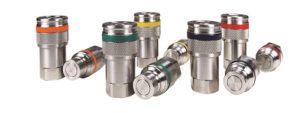Machine builders and maintenance technicians must ensure that hoses are properly secured to the correct connection. Unfortunately, when dealing with multiple hoses on a complicated machine, personnel can waste a lot of time just identifying the proper routing and mating ends. Worse, there can be equipment damage due to incorrect connections or, in the case of process fluids, product cross-contamination. All can be costly for the OEM and user.
As a straightforward solution, Dixon Quick Coupling, Dallas, N.C., developed the Correct Connect color-band design for the company’s HT-Series quick-connect couplings. The polyurethane color bands, for both the coupler and plug ends, let users quickly spot the correct mating connections.
Blue bands are standard. Other color bands (orange, green, yellow and red) are sold separately. No special tools are required for installation, and they’re field replaceable. The products are also available in connect-under-pressure HTE-Series and HTZ-Series couplings.
They can be used to easily identify seals, materials or sizes for an application; help with preventative maintenance schedules; and reduce setup time for more efficient hose routing. They’re used in a range of applications, including oilfield equipment, industrial hydraulic machinery, mobile and construction equipment, hydraulic power units, and hydraulic tools.
The HT-Series couplings are available in a range of body sizes from 0.25 to 1.0 in. They come in steel and 316 stainless-steel versions, with nitrile/polyurethane seals standard. Additional seal materials are available.
They are rated for a temperature range of -40° to 212° F (-40° to 100° C) with standard seals and pressures to 5,000 psi. The ISO 16028 flat-face design is interchangeable with Parker FEM, Stucchi FIRG – Series A, Faster FFH, Eaton FF – FD89 and Holmbury HQ quick connectors.
Dixon Quick Coupling
www.dixonvalve.com
Filed Under: Fittings, Couplings & Adapters, Hose Assembly Tips
